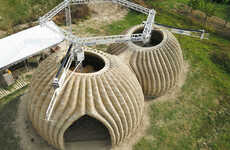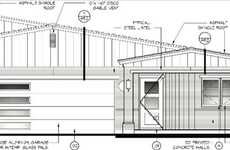
Holcim and COBOD Have Launched the 14 Trees Initiative to Build Homes
Colin Smith — December 14, 2021 — Eco
'Holcim,' a Switzerland-based building material company, has partnered up with 'COBOD,' an industrial 3D-printing company to launch the '14 Trees' initiative. Through this initiative, Holcim plans to tackle the affordable housing, sustainable housing, and housing material crises all in one go. The COBOD printers and materials from Holcim allow for a full wall of a house to be built in 12 to 18 hours. On top of this, these houses are more sustainable and cheaper to produce. The goal for the 14 Trees initiative initially is 52 3D-printed houses.
The first 3D printed home in the 14 Trees initiative is in Kenya and is a small two-bedroom house. However, the house boasts stylish minimalism which costs more than 30% less than a traditional home to build. The 3D-printing construction process consumes 70% less C02 emissions compared to traditional construction methods, meaning these homes are sustainable as well.
The cost to purchase one of these 3D-printed homes is an astonishingly low $25,000, however, this does not account for the necessary services and amenities, such as electricity and water.
Image Credit: Holcim, COBOD
The first 3D printed home in the 14 Trees initiative is in Kenya and is a small two-bedroom house. However, the house boasts stylish minimalism which costs more than 30% less than a traditional home to build. The 3D-printing construction process consumes 70% less C02 emissions compared to traditional construction methods, meaning these homes are sustainable as well.
The cost to purchase one of these 3D-printed homes is an astonishingly low $25,000, however, this does not account for the necessary services and amenities, such as electricity and water.
Image Credit: Holcim, COBOD
Trend Themes
1. Sustainable 3D Printing - The use of sustainable materials and 3D printing technology can revolutionize the construction industry, leading to cheaper and more eco-friendly homes.
2. Affordable Housing Crisis Solutions - 3D-printing technology can help address the shortage of affordable housing and provide a more cost-efficient solution than traditional construction methods.
3. Sustainable Housing - The use of sustainable materials and 3D printing technology can provide a more eco-friendly alternative to traditional housing methods.
Industry Implications
1. Construction - The construction industry can benefit from utilizing 3D-printing technology and sustainable materials to provide affordable and sustainable housing solutions.
2. Real Estate Development - Real estate developers can incorporate 3D-printing technology to reduce costs, increase efficiency, and improve sustainability in their projects.
3. Green Technology - The use of green technology, such as 3D printing with sustainable materials, can have a positive impact on the environment while also providing affordable housing options.
6.2
Score
Popularity
Activity
Freshness























